Home Blog Website Design Services Web Design 3.0 – A Complete Overview
Web Design 3.0 – A Complete Overview
- 17 May / 2021
- 3,929 views
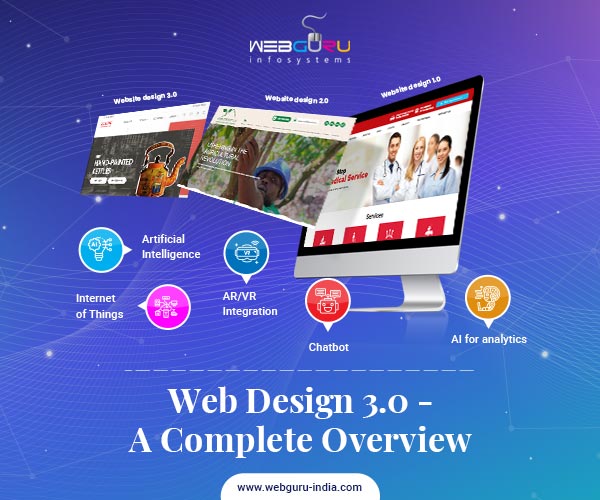
Web design trends are constantly changing and you can observe immense change between the website designs of 2000 and of today. This change, however, is not drastic – if you look closely, you can track the progress of web design.
Many web designers assert that the era of web design 3.0 is approaching. If you are not yet introduced to this evolutionary web design yet, it’s high time that you do! This blog is just about that. As a professional website development company, we took it upon ourselves to outline what this web design trend has to offer. But before that, we need to trace the transformation from web design from 1.0 to 3.0 for a better understanding.
Web Transformation – The Journey towards Web 3.0
The website design before 2000 is classified as website design 1.0 or library web. These websites were mainly text-based with minimal graphic. These had very limited interactive element and scope of sharing.
After 2000, web design gradually made a shift towards a streamlined manner of information sharing, personalization, better connectivity, etc. That’s how web 2.0 or the social web came to the forefront. The table-based format of web 1.0 gave way to grids and layouts. Bootstrap further accelerated the speed of web development by simplifying the process of designing various interactive elements. 2008 onwards, template-based web designs took the market by storm. Millions of websites were built using such themes.
As the market was filled with readymade themes, many started questioning the necessity of custom website design services. People started asking: “Is web design dead”? Curiously, this question is persistent even to this day! Check the image below.
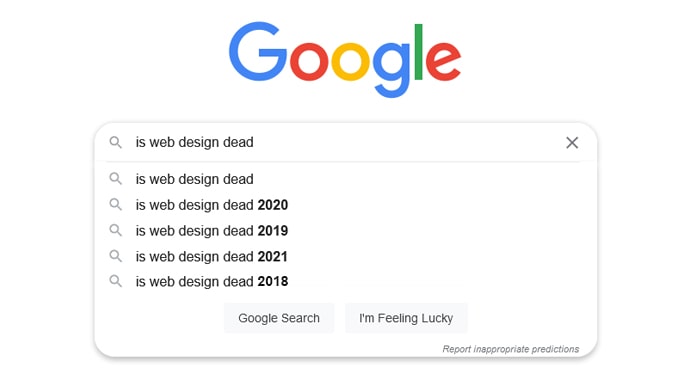 And from these queries, web 3.0 takes birth! Now, even web 2.0 is taking a backseat with the advent of artificial intelligence and high-end technologies. These are supporting the evolution of web 3.0. The concept of web 3.0 is based on the implementation of AI, machine learning, and peer-to-peer networks that offer a superb user experience.
And from these queries, web 3.0 takes birth! Now, even web 2.0 is taking a backseat with the advent of artificial intelligence and high-end technologies. These are supporting the evolution of web 3.0. The concept of web 3.0 is based on the implementation of AI, machine learning, and peer-to-peer networks that offer a superb user experience.
What is Web 3.0?
Web 3.0 seeks to offer a smart user experience with its overlapping element, breaking of the limitations of grids, contextual information (not just keyword-stuffed content), high-end security, and AI-driven design.
However, web 3.0 is not at its peak yet. It is here but at an initial stage. The concept of web 3.0 is built on a decentralized and semantic web vision that is yet to be achieved.
Futuristic Trends of Web 3.0
Artificial Intelligence
AI has transformed the realm of web development. From enhanced personalization to increased interactivity – AI ensures it all. Here are a few ways AI is used in web design:
AI as a designer – ADI (Artificial Design Intelligence) tools can bring a fundamental change in the way websites are created. These tools are effectively leveraged by web designers to create dynamic web designs. These help to reduce the number of repetitive tasks they have to perform.
AI for analytics – A variety of analytics tools is integrated into a website to identify the customers’ behaviour, requirement, and experience. These insights help to fix the issues and improve website UX.
AI for communication – Many websites have integrated chatbots for efficient communication. The latest chatbots use sophisticated NLP (Natural Language Processing) systems to continue a meaningful conversation with the users and guide them. (more on this later)
AI for voice search optimization – Optimizing website content for voice search has become a trend these days as the usage of voice-activated devices is rapidly increasing. There are various AI tools that help to create voice search optimized content by showing the questions people are asking. The Natural Language Processing system in the AI-powered tools further helps to maintain a conversational tone.
Internet of Things
Internet of Things (IoT) is changing the way we interact with the digital realm and web design 3.0 demands optimization of the user interface for various connected devices. At the same time, the websites need to have a robust backend to suit the capabilities, functionalities, and commands of different devices.
Further, the most important point to bear in mind while integrating web design with IoT is that there should be no loophole for a potential security threat. These web designs should be strategized in a way that consumes less power usage as many of the IoT devices run on battery.
AR/VR Integration
AR/VR is turning out to be the driving force of web design 3.0. These technologies help to provide an experience-based interaction and thus enhance brand reliability.
The usage of augmented reality and virtual reality create an immersive user experience. For instance, Lenskart leverages these technologies to enable the users to try different eyewear. Gucci has added an AR feature to let the users try on sneakers. Ikea Place employs VR to allow the users to find out the right piece of furniture for their space.
As you can see, AR/VR is not only a design element but also improves user interaction with the site and increase the transparency level of the brand.
Chatbot
We have briefly discussed this above but we need to elaborate it further. Chatbot has already been in use for quite some time now. So, how is it different in web design 3.0? The following sections will answer this question.
Web design 3.0 is all about providing a semantic experience to the users and chatbots also aim towards that. For instance, many web developers recommend using the latest technology like GPT-3.
GPT-3 or Generative Pre-Trained Transformer-3 is basically an AI tool that is trained with the necessary data and can create content with a natural language structure. No wonder that such a chatbot can enhance the user-friendliness of a website – a significant objective of web design 3.0.
Closing Thoughts
As you can understand, the aim of web 3.0 is to create a frictionless web design and take user experience to the next level. It is taking web design to a height that was unimaginable even a few years back. From creativity to user-friendliness – web design 3.0 has a lot of potentials yet to be unfolded.

Soumi Bhattacharya
Soumi Bhattacharya is an experienced content developer & keen observer of all things digital. Analyzing the latest trends in technology is her forte.
2 comments
Leave a Reply
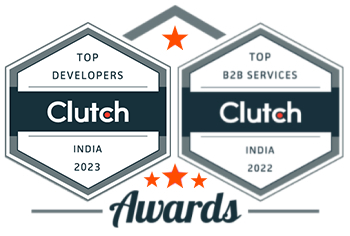
-
1000+
Happy
Clients -
25+
Countries
Served -
19+
Years of
Trust

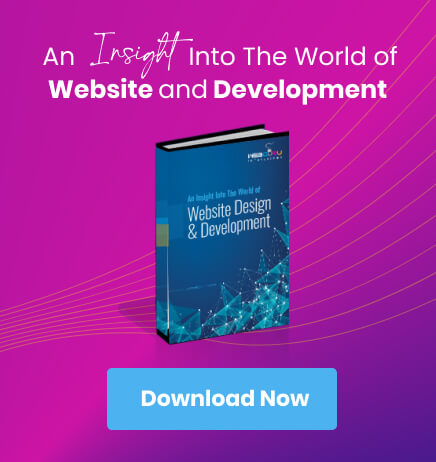
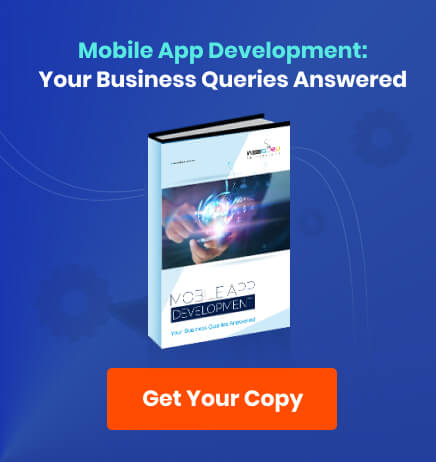





Hey, you wrote a great article on web designing, it will help a lot of people.
Thanks for sharing these valuable insights, This article provides a comprehensive overview of Web Design 3.0 and its evolving trends, I found the discussion on the shift towards more user-centric designs particularly insightful. It’s exciting to see how modern web design is becoming more intuitive and focused on delivering personalized experiences. The emphasis on performance and speed is also crucial, as these factors greatly impact user engagement and satisfaction. Overall, this piece does an excellent job of highlighting how web design is continuously adapting to meet the needs of today’s digital audience.